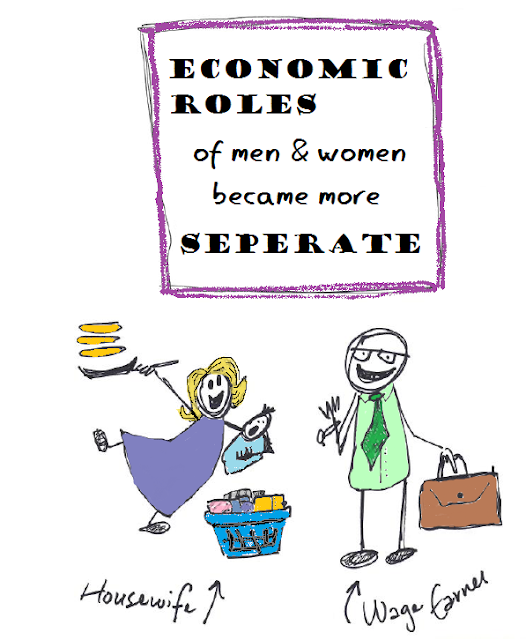This is the lecture (given in an undergraduate Family Economics course) that started it all.
The "traditional" (or nuclear) family has been viewed historically as consisting of a father (male, head-of-household, husband), mother (female, wife), and children.
Throughout history, everyone in the family worked collectively to feed, clothe, and sustain the family unit. Having lots of children meant that there were more people who could work to find food, maintain shelter and clothing, and basically keep everyone happy and fed. A woman's fertility, then, was viewed as a blessing, and it was common for families to be large and for kids to have lots of siblings.
While it's true that the men typically did the hunting, while the females did the gathering and foraging, all members of the family were actively engaged in improving everyone's chances of survival.
Actually, large families where every family member helped out with finding food and keeping everyone happy were pretty common for a long time. Sustaining a farm or a homestead required a lot of work, which involved the entire family, including children. (Also, I meant to draw a buffalo but I've only seen stuffed ones in museums and my attempt at a buffalo basically ended up looking more deer-ish than anything else. Sorry.)
In the United States, after the Civil War, the Industrial Revolution brought on technological advancement that really changed the way families were constructed, and how they operated.
In fact, the Industrial Revolution spurred a change in the traditional economic roles of men and women. The roles that women and men assumed in the family became more separate and rigid. Women were housewives and maintained the home and everything in it (including the children), while men were wage earners and spent the majority of their time outside the home, earning money.
Technological advancements, like the washing machine and refrigerator, significantly reduced the amount of time it took to do daily household chores.
So the technological advancements freed up the housewife's time in the home, but because the economic roles were still rigid, the extra free time translated to improving things around the home. That's why we see an abundance of advertisements displaying products that promise "whiter whites" or "tastier pies" in the decades following the Industrial Revolution.
These technological advancements also led to a decrease in the economic value of children. This doesn't mean a decrease in the value of children overall; it just means there was a decrease in how useful the kids were in maintaining the economy of the family.
This spurred a decrease in fertility (meaning it wasn't as attractive for women to have tons of kids anymore to help out around the house or farm). It also influenced an increase in the length of time that children spent in school.
With less children to care for, and fewer chores to do, the household 'sphere' in which so many housewives operated began to shrink.
This facilitated a movement of many women from the household into the labor market, and there was an increase in the amount of women who worked outside the home.
Right after the American Civil War, in 1870, few women worked outside the home. Those that did were employed in occupations that were low-paying. Many of the women who worked during this time were poor, minority, or immigrants.
A hundred years later, over half of women in the United States were members of the labor force. This happened due to an increase in the real wages of both men and women, and an increase in the value of a woman's time. Essentially, a woman's time was now too valuable to spend it all in the home, doing housework. So more women started entering the labor market.
With more women going into the labor market, there was an increased demand for childcare services. Additionally, researchers found that divorce rates increased as more women entered the labor force. All these changes put new stresses on families.
As a result, the government implemented public policies to address these new stresses on families, including public policies on childcare, parental leave, child support enforcement, and women's labor market earnings.
These public policies had an impact on the economic well-being of families.
The public policies helped to increase the number of dual-earner families, where both the mother and the father work outside the home. The policies also improved the well-being of female-headed families. Both of these types of families have become common in today's society.
These public policies also attempt to counteract the feminization of poverty in the United States (i.e., the situation where a disproportionate amount of women find themselves below the poverty line).
[Want the powerpoint file of this presentation? Email me.]
References used when creating this presentation:
Becker, Gary. 1991. A Treatise on the Family. Harvard University Press.
Beller, Andrea. 2011. "Historical Perspectives of the Family." Lecture Outline.














No comments:
Post a Comment